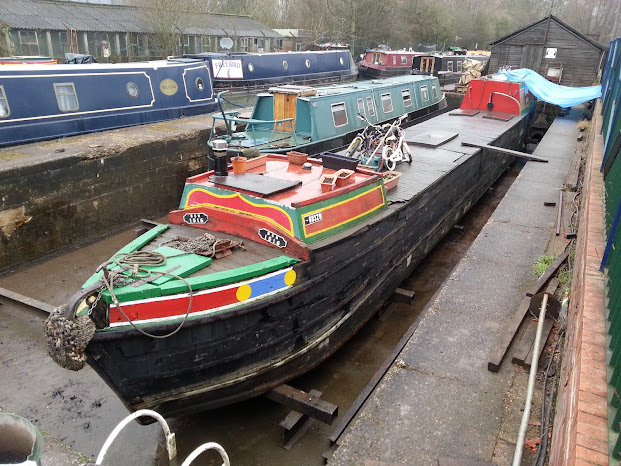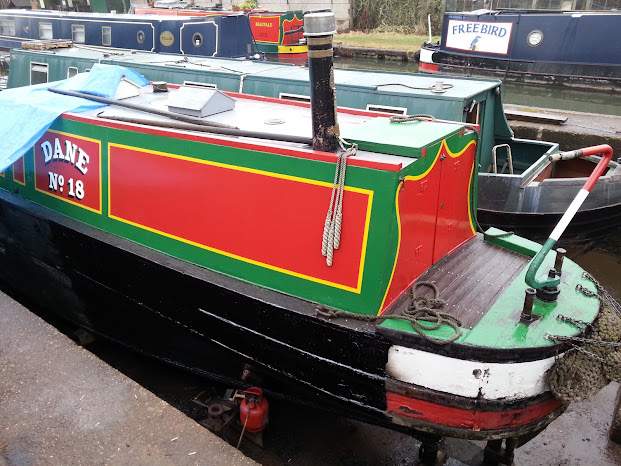What a day! We got to quite a few milestones and ‘firsts’ today with the fitout, and it feels like we’re really starting to make progress.
We had a slight lie in after stoking up the stove, and then cooked hot cross buns from a local deli and bakery, Basilia, on the stove top, having bought the last 6 yesterday for 90p. Although the stove wasn’t quite hot enough to properly toast them, they were still very nice.
Then we set to the kitchen with a will. The first task was to cut the lengths of worktop that go along the wall to size. Other pieces over the sides of the U shaped kitchen, covering the fridge and with a cutout to support the cooker, will be added later. It was fairly exacting doing the measuring, and after measuring and checking no less than five times, I made the first cut with the new Bosch jigsaw I had bought yesterday, the B&Q value one I had used previously being neither particularly accurate or powerful. Having clamped a piece of wood along to act as a guide, I was able to cut it fairly quickly. Cutouts for the sink and for an oak beam in one corner of the work top followed, and we were soon able to screw the worktops in place. The kitchen was starting to come together nicely.
The next job was to attach some battens on the edge of e worktops for the sink to sit on. The sink is designed to be used with 38mm worktops, and supports itself on two overhangs over the sides of the worktop. Because our worktop was the significantly cheaper 28mm thick variety, it would not have properly fitted, but we thought of this and had bought a couple of 10mm square section strips, to put under the lips on the sides of the sink and support it at the right height.
Then it was a matter of attaching up the tap and sink waste to the fittings installed earlier. Simon’s father, Ron, had helpfully made up a fitting with a sea cock and a tee to put the sink wet and the pipe from the sump in the bathroom onto. Because our skin fitting isn’t a standard domestic size, we’ve had to use a temporary flexible plastic tube, designed for overflows, which should last until we can get some better tube to replace it. After a bit of faffing with tape and jubilee clips, the waste was waterproof and working well, so it was time for the moment of truth; mount the main supply cable to the electrical panel onto the battery terminal and turn on the water pump to see if any leaks appeared.
Whilst the inaccessible plumbing was mercifully leak free, the Paloma annoyingly was spurting water from a drain down valve with no plug in it, so we turned off the pipe, removed the Paloma- which we were going to do anyway to cut the hole in the roof- and put on a temporary stop end on the supply pipe, so we could use the tap and sink with cold water.
This time, when the pump was turned on, we were able to use the sink freely with no leaks. The inline Jabsco filter is working well, and the water is quite free from any taint or odour and quite nice to drink.
The next job was to make the hole in the roof for the Paloma to exhaust through. After carefully measuring the centre of the hole in the cabin lining, which had already been cut out, I drilled through from the inside, and was then able to use a piece of wood with a screw through one end and a pencil to mark out the radius of the circle I wanted to cut. It was heavy going cutting through the 4mm steel, but the drill made it, with the addition of WD40 as makeshift cutting oil to the holes every now and then. It took about an hour to drill 25 closely spaced holes around the circumference of the circle marked out on the roof, but unfortunately just as I was using the jigsaw to start to join the holes together and complete the cut, the HSS blade snapped. Whilst there is another one, somewhere on the boat, we couldn’t find it anyway, and with it being Easter Sunday, the shops were all shut so couldn’t get more.
We had a quick walk along the cut as the sun set, and then whilst Amy was cooking a simple pasta dinner on a portable camping stove- stored in the gas locker when not in use, I don’t trust the seal on the cartridges supplied- I connected up the LED light fitting I had put up yesterday, and we were able to have a nice bright light in the kitchen to wash up by. The kitchen now looks like a kitchen, and we’ve been able to remove the food, plates and bowls, and other domestic bits and pieces from the plastic crate where it had been stored and put them away in the kitchen cupboards.

As mentioned, several firsts today; first running water, first working permanently wired in lights, and, first proper meal cooked on board. Already the boat is starting to feel more homely and far less like spartan camping. OK hot water still needs to come from the top of the solid fuel stove in a pan, or from the kettle whilst on the shoreline, and we can only cook on a camping stove, but it’s much, much less basic than it was.










































Recent Comments